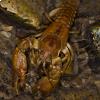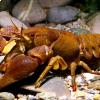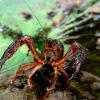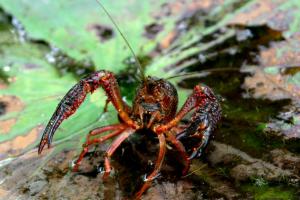Il gambero di fiume (Austropotamobius pallipes Lereboullet, 1858) è un piccolo crostaceo d'acqua dolce, della famiglia degli Astacidae.
Vive nei torrenti e nei fiumi particolarmente ossigenati. Preferisce i letti ghiaiosi o sabbiosi ma dotati di rive in cui siano presenti anfratti e luoghi sicuri, rappresentati spesso da fronde di alberi caduti o foglie, per potersi nascondere e riposare. Nel Parco Nazionale del Cilento e Vallo di Diano è stato rinvenuto nel bacino del Bussento. In passato si ha notizia della sua presenza anche in località Fuonti (frazione Pucara) a Tramonti.
Un progetto del Parco del Cilento si è proposto di approfondire gli studi sul suo status nelle aste fluviali, finalizzato alla pianificazione della gestione e della conservazione della specie considerata vulnerabile in base ai criteri della IUCN red list.
In molti paesi europei viene soprannominato "Gambero dai piedi bianchi" per la caratteristica colorazione degli artii e del ventre in contrasto col resto del corpo che si presenta dal bruno rossiccio fino al verde scuro a volte con tinte più chiare vicine al giallastro. Particolarmente tozzo e dal carapace robusto, può raggiungere gli 11-12 cm di lunghezza e i 90 g di peso.I gamberi hanno i sessi separati: ci sono quindi individui maschi e individui femmine.
Il periodo riproduttivo si situa nei mesi di ottobre e novembre. L'accoppiamento e la fecondazione risultano dei momenti piuttosto violenti, infatti il maschio afferra con le chele la femmina e la gira sul dorso: può capitare che quest'ultima subisca delle mutilazioni o addirittura muoia.
In seguito il maschio, con le prime due paia di appendici addominali (i pleiopodi) modificati in organi riproduttivi (gonopodi) depone un pacchetto di spermatozoi nei pressi degli orifizi genitali della femmina, con lo scopo di fecondare le uova che verranno poi deposte.
Nel caso di un gambero di fiume la femmina può deporre fino a 80 - 100 uova. Questo numero è superiore per il gambero americano, il quale raggiunge le 200 - 440 uova, ciò spiega la sua riproduzione molto rapida.
Le uova fecondate vengono incubate sotto l’addome della femmina fino alla primavera seguente, quando poi si schiudono dando vita a giovani gamberi con un aspetto già simile a quello degli adulti. La crescita dei gamberi, per mezzo delle mute, è molto lenta, per raggiungere 9 cm sono necessari almeno 4 – 5 anni.
La temperatura dell’acqua ha un ruolo fondamentale in questi processi: il periodo di incubazione delle uova, può variare tra i 5 e i 7 mesi con acqua più o meno fredda, la crescita del corpo è anche rallentata da acque particolarmente fredde.
È un animale tipicamente notturno. Si nutre di qualunque cosa: dalle alghe alle piante acquatiche, dai vermi ai molluschi, alle larve di insetti.
Si dimostra particolarmente aggressivo nella difesa del suo territorio e nelle lotte sessuali, come dimostrano le catture di esemplari con arti o chele parzialmente o totalmente mutilate.
I gamberi di fiume devono sfuggire continuamente a numerosi predatori che, come l'uomo, ne apprezzano le carni.

The Atlantic stream crayfish is a small freshwater crustacean of the Astacidae family.
It lives in oxygenated streams and rivers. It prefers gravelly or sandy beds but with the banks where there are shelters, often represented by branches of fallen trees or leaves, in order to hide and rest. In the National Park of Cilento and Vallo di Diano it was found in the basin of Bussento. In the past we have news of its presence also in Fuonti (fraction Pucara) in Tramonti.
A project of the Park of Cilento has proposed further study on its status in the river courses, aiming at planning the management and conservation of the species considered vulnerable according to the criteria of the IUCN red list.
In many European countries it is called "white-clawed crayfish" for the colour of it claws and belly at odds with the rest of the body that comes from the reddish brown to dark green, sometimes with lighter shades close to yellow. With a stout and sturdy shell, it can reach 11-12 cm in length and 90 g in weight. The species have separate sexes with male and female individuals.
The reproductive period is from October to November. The mating and fertilization are rather violent moments, in fact the male grabs the female with the claws and turns it on its back, sometimes resulting in that the latter suffers mutilation or even die.
After that, the male, with the first two pairs of abdominal appendages (pleiopodi) modified in the reproductive organs (gonopods), lays a package of sperm in the vicinity of the orifices of the female genitalia, with the aim to fertilize the eggs that will then be deposited.
The female can lay up for 80 - 100 eggs. This number is higher for the American crayfish, which reaches 200-440 eggs.
The fertilized eggs are incubated under the abdomen of the female until the following spring when then hatch giving birth to young shrimps with an aspect already similar to that of adults. The water temperature has a key role in these processes: the incubation period of the eggs, can vary between 5 and 7 months with more or less cold water, and the body growth is also slowed by particularly cold water.
It is a typical nocturnal animal. It feeds on anything: from algae to aquatic plants, shellfish, and insect larvae.
It is particularly aggressive in the defence of its territory and in sexual struggles, as shown by the catch of individuals with partially or totally mutilated limbs or claws.
The crayfish must constantly escape many predators, such as the human being that appreciate its meat.





